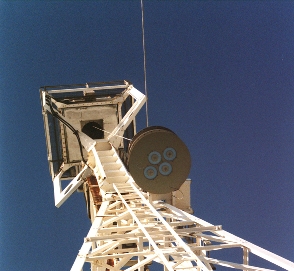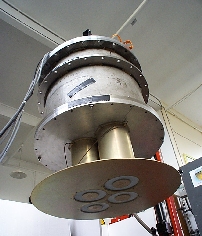


The Multi-Beam Receiver being hoisted to the Focus Box.
A radio telescope usually receives radio waves from only a single small
area of the sky. A `feed horn' collects these signals which are then
amplified in a high-performance receiver. This is cooled to close to
absolute zero to minimise its noise contribution and hence achieve the
maximum possible sensitivity. If, however, we need to survey a broad
region of the sky, the time taken can be greatly reduced by clustering
several feed horns together in the focal region of the telescope so that
they can simultaneously observe adjacent areas of the sky.
Each feed horn is slightly offset from the axis of the telescope
and thus receives radio waves from a different region of sky than the
others By aligning them correctly by rotating the whole system, they can
be made to scan several parallel strips of the sky for each scan of the
telescope.
The system installed on the Lovell Telescope uses four feed horns. Their
associated receivers are kept at 30 K within a large, cooled enclosure.
The telescope had to be considerably modified to allow the equipment to be
hoisted up and mounted at the focus.

The Multi-Beam Feeds and Cryostat in the Cryogenic Laboratory.
The Lovell and Parkes telescopes will carry out the two surveys together. The pulsar search is already underway at Parkes and is proving spectacularly successful with, on average, one new pulsar being discovered for each hour of observing time. Some 800 pulsars have been discovered in the 30 years previous to the new survey, but this number should increase by 50 per cent, since it is expected to identify another 400 or more pulsars in the next two years. The number now known already exceeds 1000! Without the multi-beam systems at Jodrell Bank and Parkes this new survey would have taken well over 10 years. Meanwhile the multi-beam system on the Lovell telescope has been used to carry out a survey of the Ursa-Major cluster of galaxies.
The Multi-Beam System was installed on the Lovell Telescope at the beginning of 1999 for a 6 week observing session to study the Ursa Major and Virgo Clusters. The Virgo observations are linked with a deep ccd optical survey of the Virgo Cluster being carried out by astronomers at Cardiff University and their collaborators. The system is also being used to carry out a "blind" survey of a region near to the North Celestial Pole which will act as a field comparison for the two cluster surveys.

|
Return to the Jodrell Bank Home page |